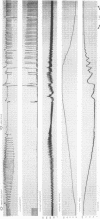Abstract
We have tested the hypothesis that severe lypoxia causes apnea, regardless of the arterial CO2 and pH, and that extreme hypoxia causes gasping. Acute experiments with airway occlusion and with low inspired oxygen (FIo2) were performed on anesthetized adult dogs and monkeys. Arterial oxygen saturation was recorded continuously with fiberoptic oximetry, and Pco2 by an electrode catheter. In addition, blood samples were obtained for Po2, Pco2, and pH. Apnea was induced regularly when the Pao2 fell below 10 torr, whether the Paco2 was high with asphyxia (63 torr) or low (26 torr) with low FIo2. Similarly, the Pao2 at apnea was the same whether the pH was 7.17 with asphyxic hypoxia or 7.46 with hypoxic hypoxia. Gasping occurred at even lower Pao2 (below 5 torr) after 1 or 2 min of apnea. Gasping promptly restored the Pao2 to levels of moderate hypoxia (over 30 torr) which permitted resumption of regular respiration, with gradual elimination of the gasping. Fetal monkeys at term were studied in a similar manner from the moment of cord clamping. Their blood gases with apnea were quite similar to adult values in the narrow range of Pao2 and the wide range of Paco2 and pH. In the fetus, gasping was less immediately effective in improving arterial oxygen, but more persistent than in the adult. Regular respirations would not develop in the absence of oxygen in either the fetus or adult animal.
Full text
PDF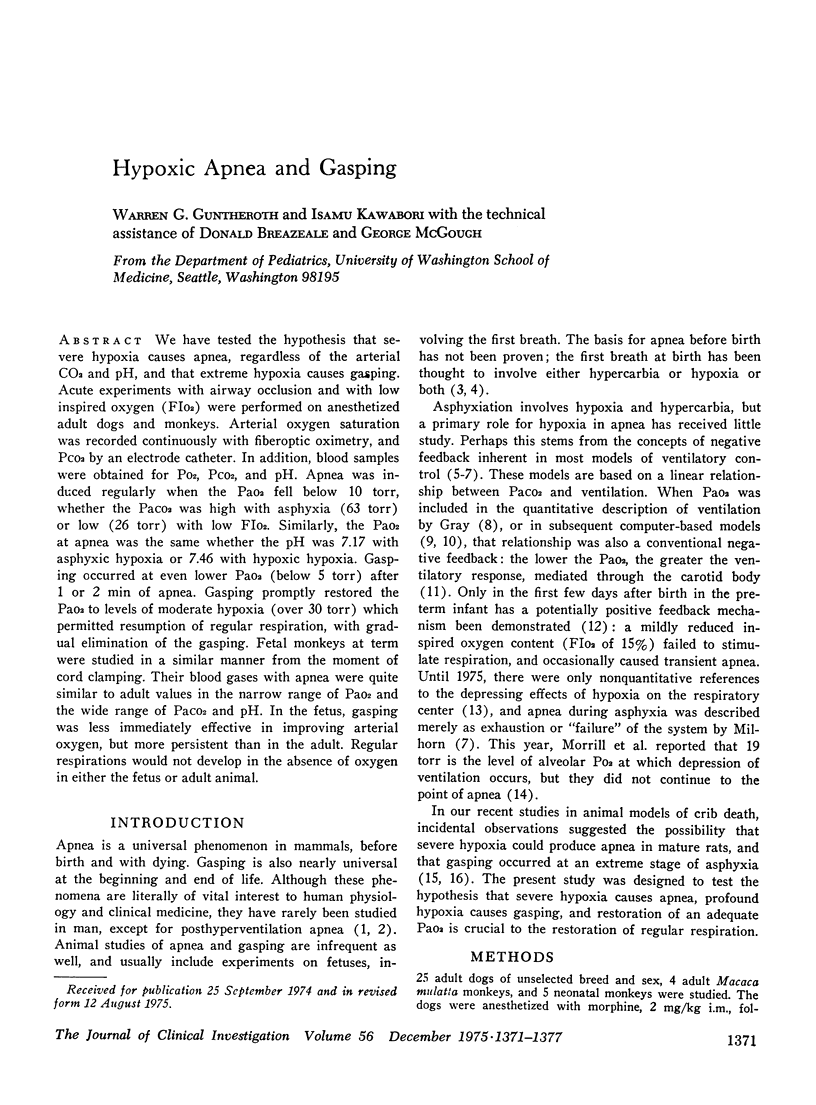
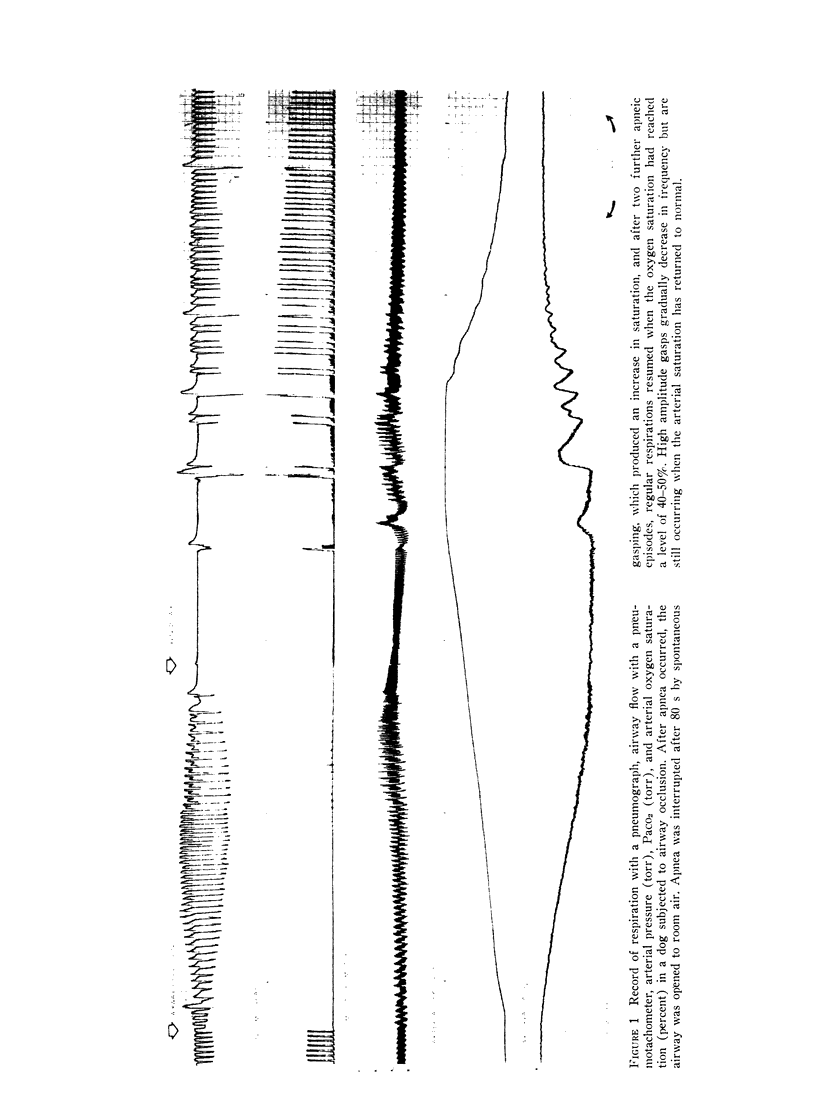
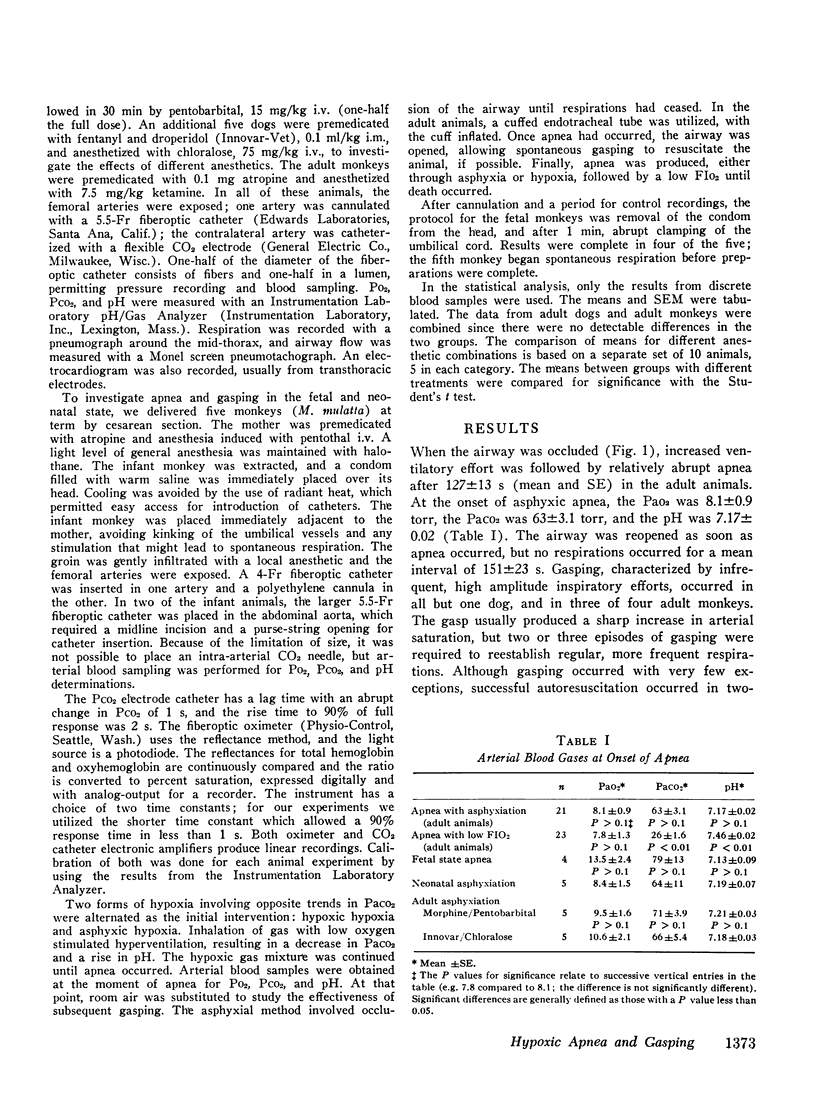

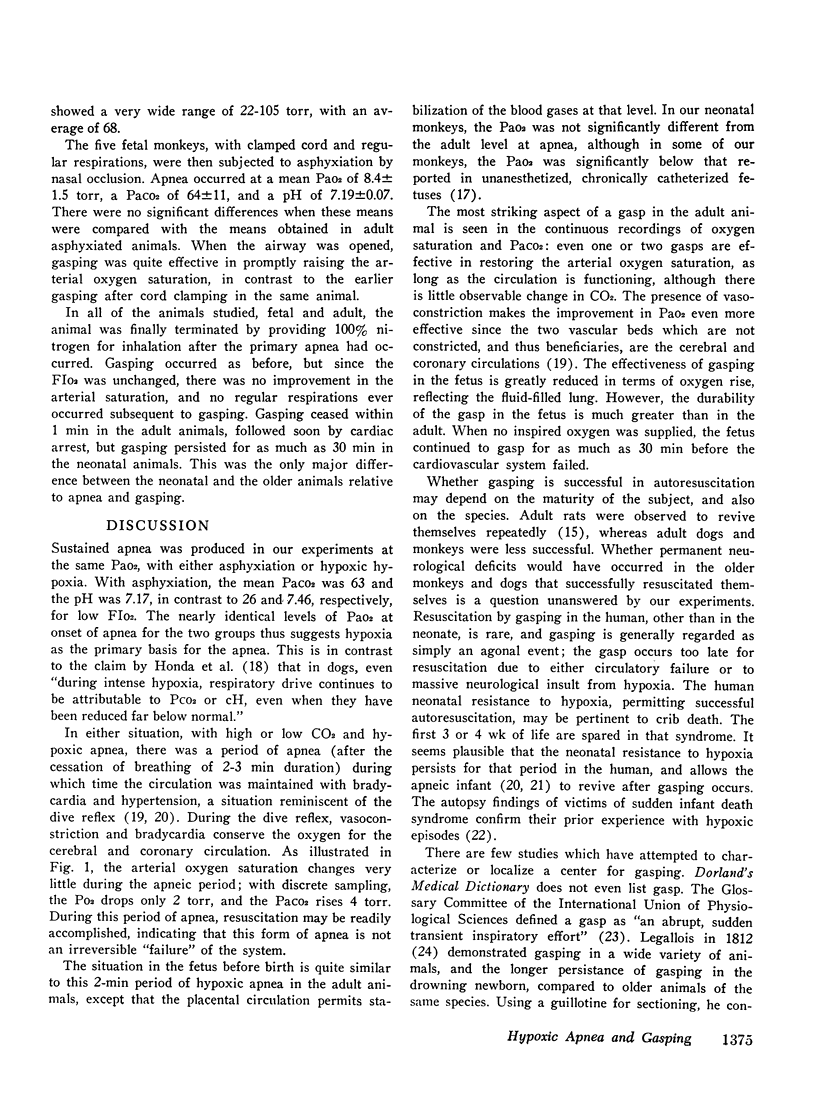


Images in this article
Selected References
These references are in PubMed. This may not be the complete list of references from this article.
- Cherniack N. S., Longobardo G. S. Cheyne-Stokes breathing. An instability in physiologic control. N Engl J Med. 1973 May 3;288(18):952–957. doi: 10.1056/NEJM197305032881810. [DOI] [PubMed] [Google Scholar]
- Chernick V., Faridy E. E., Pagtakhan R. D. Role of peripheral and central chemoreceptors in the initiation of fetal respiration. J Appl Physiol. 1975 Mar;38(3):407–410. doi: 10.1152/jappl.1975.38.3.407. [DOI] [PubMed] [Google Scholar]
- Dawes G. S., Duncan S. L., Lewis B. V., Merlet C. L., Owen-Thomas J. B., Reeves J. T. Cyanide stimulation of the systemic arterial chemoreceptors in foetal lambs. J Physiol. 1969 Mar;201(1):117–128. doi: 10.1113/jphysiol.1969.sp008746. [DOI] [PMC free article] [PubMed] [Google Scholar]
- Douglas C. G., Haldane J. S. The regulation of normal breathing. J Physiol. 1909 Jun 15;38(5):420–440. doi: 10.1113/jphysiol.1909.sp001315. [DOI] [PMC free article] [PubMed] [Google Scholar]
- FINK B. R. The stimulant effect of wakefulness on respiration: clinical aspects. Br J Anaesth. 1961 Feb;33:97–101. doi: 10.1093/bja/33.2.97. [DOI] [PubMed] [Google Scholar]
- French J. W., Morgan B. C., Guntheroth W. G. Infant monkeys--a model for crib death. Am J Dis Child. 1972 May;123(5):480–484. doi: 10.1001/archpedi.1972.02110110108011. [DOI] [PubMed] [Google Scholar]
- GRODINS F. S., GRAY J. S., SCHROEDER K. R., NORINS A. L., JONES R. W. Respiratory responses to CO2 inhalation; a theoretical study of a nonlinear biological regulator. J Appl Physiol. 1954 Nov;7(3):283–308. doi: 10.1152/jappl.1954.7.3.283. [DOI] [PubMed] [Google Scholar]
- Guntheroth W. G. The significance of pulmonary petechiae in crib death. Pediatrics. 1973 Oct;52(4):601–603. [PubMed] [Google Scholar]
- HONDA Y., NATSUI T., HASUMURA N., NAKAMURA K. THRESHOLD PCO2 FOR RESPIRATORY SYSTEM IN ACUTE HYPOXIA OF DOGS. J Appl Physiol. 1963 Nov;18:1053–1056. doi: 10.1152/jappl.1963.18.6.1053. [DOI] [PubMed] [Google Scholar]
- HORNBEIN T. F., GRIFFO Z. J., ROOS A. Quantitation of chemoreceptor activity: interrelation of hypoxia and hypercapnia. J Neurophysiol. 1961 Nov;24:561–568. doi: 10.1152/jn.1961.24.6.561. [DOI] [PubMed] [Google Scholar]
- HUKUHARA T., NAKAYAMA S., YAMAGAMI M. On the behavior of the respiratory muscles in the gasping. Jpn J Physiol. 1959 Jun 25;9(2):125–129. doi: 10.2170/jjphysiol.9.125. [DOI] [PubMed] [Google Scholar]
- Harned H. S., Jr, MacKinney L. G., Berryhill W. S., Jr, Holmes C. K. Effects of hypoxia and acidity on the initiation of breathing in the fetal lamb at term. Am J Dis Child. 1966 Oct;112(4):334–342. doi: 10.1001/archpedi.1966.02090130108010. [DOI] [PubMed] [Google Scholar]
- Herrington R. T., Harned H. S., Jr, Ferreiro J. I., Griffin C. A., 3rd The role of the central nervous system in perinatal respiration: studies of chemoregulatory mechanisms in the term lamb. Pediatrics. 1971 May;47(5):857–864. [PubMed] [Google Scholar]
- Jansen A. H., Chernick V. Cardiorespiratory response to central cyanide in fetal sheep. J Appl Physiol. 1974 Jul;37(1):18–21. doi: 10.1152/jappl.1974.37.1.18. [DOI] [PubMed] [Google Scholar]
- Jansen A. H., Chernick V. Respiratory response to cyanide in fetal sheep after peripheral chemodenervation. J Appl Physiol. 1974 Jan;36(1):1–5. doi: 10.1152/jappl.1974.36.1.1. [DOI] [PubMed] [Google Scholar]
- Longobardo G. S., Cherniack N. S., Fishman A. P. Cheyne-Stokes breathing produced by a model of the human respiratory system. J Appl Physiol. 1966 Nov;21(6):1839–1846. doi: 10.1152/jappl.1966.21.6.1839. [DOI] [PubMed] [Google Scholar]
- Lumsden T. Observations on the respiratory centres in the cat. J Physiol. 1923 Mar 21;57(3-4):153–160. doi: 10.1113/jphysiol.1923.sp002052. [DOI] [PMC free article] [PubMed] [Google Scholar]
- Martin C. B., Jr, Murata Y., Petrie R. H., Parer J. T. Respiratory movements in fetal rhesus monkeys. Am J Obstet Gynecol. 1974 Aug 1;119(7):939–948. doi: 10.1016/0002-9378(74)90011-8. [DOI] [PubMed] [Google Scholar]
- Morrill C. G., Meyer J. R., Weil J. V. Hypoxic ventilatory depression in dogs. J Appl Physiol. 1975 Jan;38(1):143–146. doi: 10.1152/jappl.1975.38.1.143. [DOI] [PubMed] [Google Scholar]
- Rigatto H., Brady J. P. Periodic breathing and apnea in preterm infants. II. Hypoxia as a primary event. Pediatrics. 1972 Aug;50(2):219–228. [PubMed] [Google Scholar]
- Sorensen S. C. The chemical control of ventilation. Acta Physiol Scand Suppl. 1971;361:1–72. [PubMed] [Google Scholar]
- Steinschneider A. Prolonged apnea and the sudden infant death syndrome: clinical and laboratory observations. Pediatrics. 1972 Oct;50(4):646–654. [PubMed] [Google Scholar]
- Woodrum D. E., Parer J. T., Wennberg R. P., Hodson W. A. Chemoreceptor response in initiation of breathing in the fetal lamb. J Appl Physiol. 1972 Jul;33(1):120–125. doi: 10.1152/jappl.1972.33.1.120. [DOI] [PubMed] [Google Scholar]



